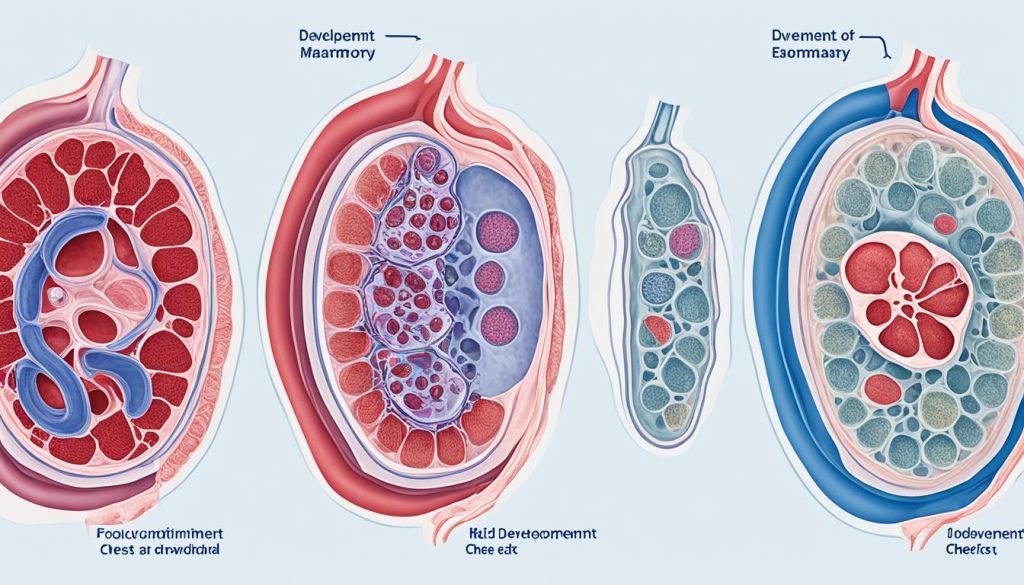Poland Syndrome is a unique condition, where people have uneven bodies due to chest and muscle differences. It was first found in the 1800s. Medical experts are still learning about it. Mainly, it affects chest muscles and sometimes arms. The exact reasons why it happens are still unknown, making research vital. Treating Poland Syndrome focuses on making the person look and feel better. This might involve surgery or other methods.
Key Takeaways
- Poland Syndrome is a congenital malformation characterised by unilateral chest wall deformity and muscular deficiency.
- The causes of Poland Syndrome remain largely unknown, highlighting the importance of ongoing research.
- Treatment of Poland Syndrome is personalised, often involving a combination of therapeutic approaches.
- Effective management aims to address both the physical and psychological impact of the asymmetric body condition.
- Understanding the nuances of this congenital condition is essential for advancing treatments and improving affected individuals’ quality of life.
Exploring the Origins of Poland Syndrome
The embryological development of humans is a complex process. Genetics and environment must align perfectly for normal growth. Any disruptions can lead to conditions like Poland Syndrome. The origin of Poland Syndrome is believed to be complex. It includes genetic factors and vascular disruption during key growth phases.
Studies focus on vascular disruption in the sixth week of life. This time is crucial for chest and limb growth. Interference here can cause Poland Syndrome’s uneven abnormalities. Researchers look at case studies and historical data. They search for development errors linked to Poland Syndrome.
- Analysis of Family History to Identify Genetic Links
- Investigation of Subclavian Artery Development in Foetal Stages
- Examination of Epidemiological Data to Determine Incidence Rates

By combining genetic and vascular research, scientists aim to better understand Poland Syndrome. They hope this might lead to prevention or treatment methods. Despite advancements, the condition’s rarity and variability remain challenging for experts.
| Embryological Phase | Potential Disruptive Factor | Resultant Poland Syndrome Feature |
|---|---|---|
| Limb Bud Formation | Genetic Mutations | Musculoskeletal Anomalies |
| Chest Wall Development | Vascular Disruption | Chest Wall Deformity |
| Muscle Differentiation | Environmental Insults | Absent or Underdeveloped Musculature |
Research into Poland Syndrome shows its complex causes. It involves embryological development and vascular disruption. Experts also consider external factors. This knowledge helps in treating and supporting those with Poland Syndrome.
Poland Syndrome: Diagnosis and Management Strategies
The journey towards managing Poland Syndrome starts with a clinical diagnosis. Healthcare experts use physical examination and imaging techniques to spot Poland Syndrome signs. The diagnosis involves looking for unique features like chest muscle anomalies and sometimes, rib defects.
Identifying Characteristics of Poland Syndrome
The search for Poland Syndrome focuses on finding its key signs. Criteria include chest muscle underdevelopment and rib cage irregularities. For clarity, MRI and CT scans are crucial in showing these structural differences.
Medical Interventions for Poland Syndrome
Picking a non-surgical treatment route offers many benefits. Through occupational therapy and physical therapy for Poland Syndrome, patients see improved functionality and quality of life. This helps in gaining more independence.
Surgical Options for Corrective Treatment
In the surgical sphere, chest wall reconstruction and muscle transfer are key for better looks and symptom relief. This reconstructive surgery significantly boosts a person’s self-esteem and mental well-being.
Supportive Therapies and Rehabilitation
Handling Poland Syndrome long-term needs a team approach. Adding psychological support and special rehabilitation programs is crucial for all-around care. This ensures those affected get the right support.
| Management Aspect | Approach | Expected Outcome |
|---|---|---|
| Physical Examination & Imaging | Use of MRI/CT scans to detect anatomical anomalies | Accurate clinical diagnosis of Poland Syndrome |
| Occupational & Physical Therapy | Activities to improve motor skills and daily functioning | Enhanced independence and quality of life |
| Reconstructive Surgery | Chest wall reconstruction, muscle transfer | Improved physical appearance and comfort |
| Psychological Support & Rehabilitation | Individualised support programs | Emotional resilience and social reintegration |
Conclusion
To sum up our look at Poland Syndrome, we see how key it is to grow our knowledge of it. This knowledge helps us improve how we treat it and makes life better for those who have it. With every piece of research, we find better ways to care for and support people with this rare condition.
Finding new ways to treat Poland Syndrome and make life better is so important. Doctors and scientists are working hard to find better, easier treatments. They want to help everyone with Poland Syndrome live a full, happy life with as little stress as possible.
As we finish this article, it’s clear how important it is to support people with Poland Syndrome. With new technology and help, there’s hope for a better future. Together, we’re working to understand Poland Syndrome better and find treatments that don’t just deal with symptoms but truly help those affected.
FAQ
What is Poland Syndrome and how does it manifest?
Poland Syndrome is a rare condition you’re born with. It makes one side of the body look different because of a chest wall deformity. This often includes missing chest muscles and sometimes problems with ribs and the upper arm.
What are the causes of Poland Syndrome?
We’re not exactly sure what causes Poland Syndrome. It seems to happen when something goes wrong with the baby’s development in the womb. Some scientists think it could be due to genetic factors or something affecting blood flow at key development times.
How is Poland Syndrome diagnosed?
Doctors diagnose Poland Syndrome by looking at the body and using scans like MRI or CT. They look for signs like less developed chest muscles or unusual ribs. Each diagnosis is based on what the syndrome typically looks like.
What non-surgical treatments are available for Poland Syndrome?
For people not going through surgery, treatments include physical therapy and made-to-order prosthetics. These help improve how they move and look. Each treatment is tailored to fit the person’s own needs.
What surgical options exist for the corrective treatment of Poland Syndrome?
Surgery for Poland Syndrome can involve rebuilding the chest wall or moving muscles around. The goal is to make the chest look and work better. Doctors plan these surgeries carefully for the best look and function.
Can individuals with Poland Syndrome lead a normal life?
Yes, many with Poland Syndrome have full, active lives. The right medical help and emotional support can make a big difference. Special treatments and programs help them manage their condition well.
Why is understanding the origins of Poland Syndrome important?
Knowing why Poland Syndrome happens helps improve how we treat it. Figuring out what goes wrong during development can guide new treatments. Better understanding means better care for those affected.
Are there supportive therapies for individuals with Poland Syndrome?
Yes, support like counseling and social programs is key for living with Poland Syndrome. They help with physical, emotional, and social challenges. This boosts overall happiness and health.
Is the prevalence of Poland Syndrome the same in males and females?
More men have Poland Syndrome than women. But the exact numbers vary in different studies. Learning more about who gets it helps us understand it better.
How can advancements in medical science help those with Poland Syndrome?
New tools and surgeries offer big hope for those with Poland Syndrome. Continued innovation means treatments get better. This can greatly improve life for those with the condition.



